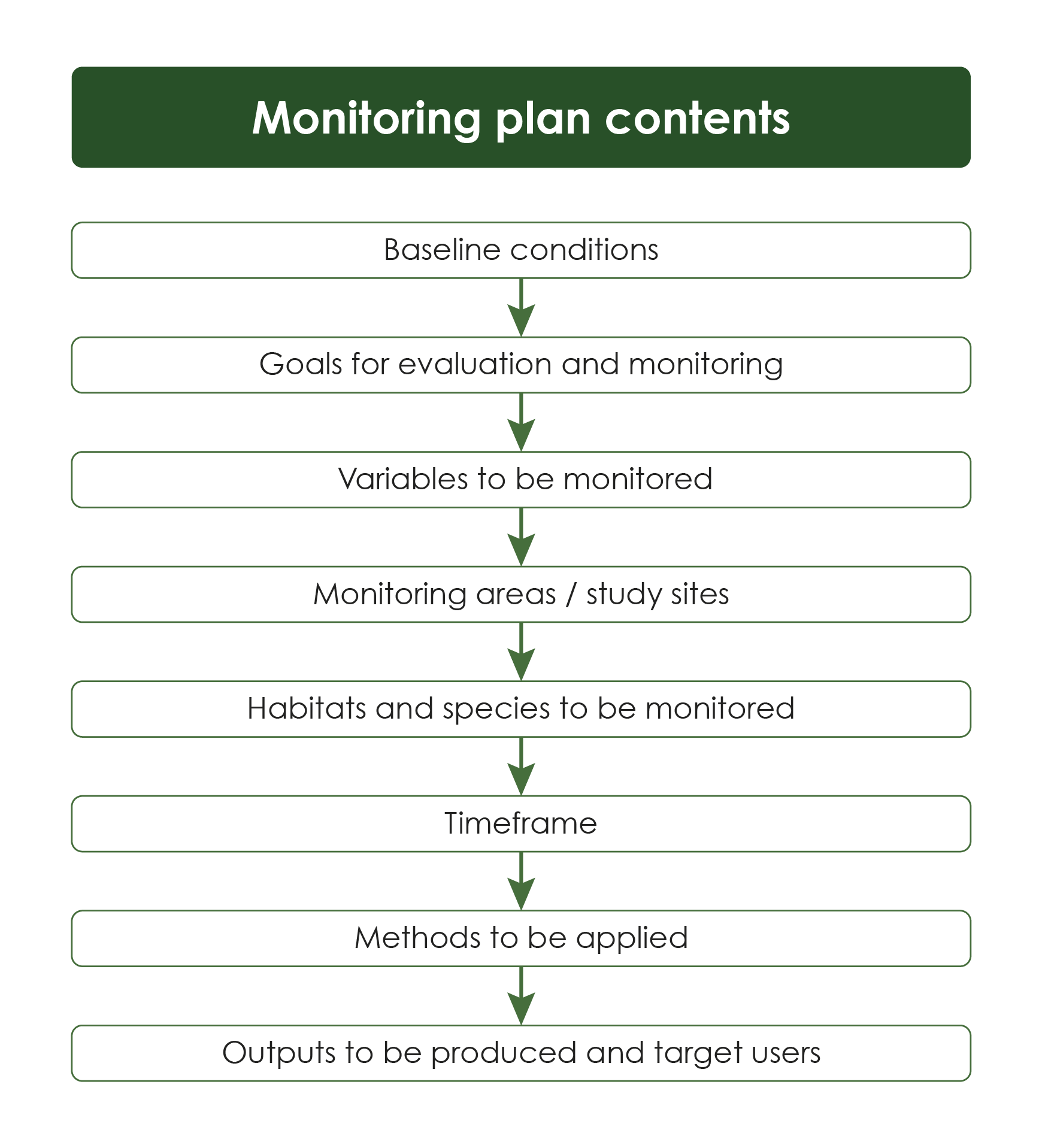Monitoring plan framework
Designing monitoring plans must be an integral part of the preparation process for the construction or upgrading of transport infrastructure. The monitoring plan needs to cover the entire process from obtaining and analysing data about baseline conditions (i.e., relevant studies or local species data which are often used for analyses and setting the targets and goals of monitoring) to the definition of the outputs to be delivered to authorities and other target users (i.e., the structure and contents of the reports and other presentations, as well as submission dates which are fixed on a schedule).
The monitoring plan should be designed, discussed, and approved within the EIA process and will be different depending on the goals (see Section 6.1.1 – Goals of monitoring and evaluation). However, all monitoring plans must include the following elements (Figure 6.2.1):
- Information on the baseline conditions from which the programme is developed. All biological surveys and studies undertaken in the study area are input data for the preparation of the monitoring plan. Using this information, a biodiversity baseline will be defined from which a selection of the target species and habitats to be monitored is made.
- Definition of evaluation and monitoring goals. The monitoring plan should be designed according with the goals for evaluation. It must determine whether the mitigation measures put in place to manage impacts of the infrastructure on key species and habitats are being effective and apply appropriate corrective actions, if needed. See also Section 6.1 – The general principles for a 4-step iterative process to define variables, metrics, and indicators based on evaluation objectives.
- Variables to be monitored. The variables to be monitored must be determined according to the goals and in such a way that sufficiently describe the effect of a specific infrastructure on local habitats and species (including migratory species passing through the affected area). They will be different according to:
- Biological question addressed.
- Type of transport infrastructure – different parameters will be monitored for highways, roads, railways, or water channels, power lines, etc.
- Scope of construction/upgrading – while monitoring the impact of the reconstruction of a small bridge on local road will focus on only a few local species, monitoring the construction of a highway or a high-speed railway will include a comprehensive assessment of the impacts on the entire spectrum of habitats and species.
- Site location – monitoring of infrastructure placed in a built-up area will be different to that for monitoring in an agricultural landscape or in areas of high biodiversity value, such as protected areas or ecological corridors connecting them.
- Delineation of the monitoring areas. Defining the monitoring area is a key step of the process and must be based on the subjects and variables to be monitored. The scale should be defined according to the area expected to be affected and, in the case of wildlife, according to the species movement and dispersal capacities. While for invertebrates, amphibians or reptiles the monitoring area could be focused on local populations near the construction site, for large carnivores the impacts on populations need to monitor and evaluate large areas, often including transboundary sites, depending on the species home range.
- Habitats and species to be monitored. Monitoring should always consider habitat fragmentation, especially the maintenance of functional connections across the landscape. The quality of habitats is subject to monitoring if these habitats have been directly affected by construction or are newly created as part of compensation. Habitats newly created on road and railway sides also require special attention. The selection of species to be monitored should be based on previous knowledge on their occurrence and migrations. Special attention should be paid to endangered and migratory species (the existence of migration corridors for occasional migrants can be essential for the survival of populations far from the construction site). As it is not possible to monitor in detail all the species present in an area, species or groups of species need to be selected. Species with particular habitat requirements, species of high conservation value and species whose requirements encompass those of other species (umbrella species) are priority targets for monitoring plans. These priority targets often depend on local, national and regional regulations.
- Timeframe. The monitoring timeframe must be sufficient to determine the impact of the transport infrastructure development on biodiversity targets. Monitoring should cover a period of at least 2-3 years before the construction starts, continue during construction until completion and then 3 to 10, and even 15 years, are suitable during operation, depending on the question to be addressed and the metrics measured. The exact time frame must always be defined according to goals and achieving a reliable assessment of the effects being monitored and may depend on regulations. When relevant, the Before-After-Control-Impact BACI system (see Section 6.2.2 – Schemes, methods and techniques) is recommended to be applied and would drive the monitoring timeframe.
- Methods to be applied. Detailed description of the scheme monitoring methods, the techniques used and the frequency of measurements, must be described for each species and habitat included in the monitoring plan (see Section 6.2.2 – Schemes, methods and techniques and Sections 6.3 – Field techniques applied to wildlife monitoring for a description of recommended monitoring methods).
- Outputs to be produced and target users. Form and scope of monitoring results for the evaluation must be described in the monitoring plan, including the frequency of reporting. Monitoring reports are recommended to be submitted annually. An evaluation planning should be proposed and each evaluation lead to a dedicated report. Evaluation reports must be delivered at least to the infrastructure manager, the nature protection authorities and the authorities responsible for approving transport infrastructure. This report should include:
- Analysis of achieved results.
- Assessment of the effect of a specific construction on habitats and populations of monitored species.
- Recommendations for subsequent operation and maintenance.
- Recommendations to be applied in other similar infrastructure and conditions.
